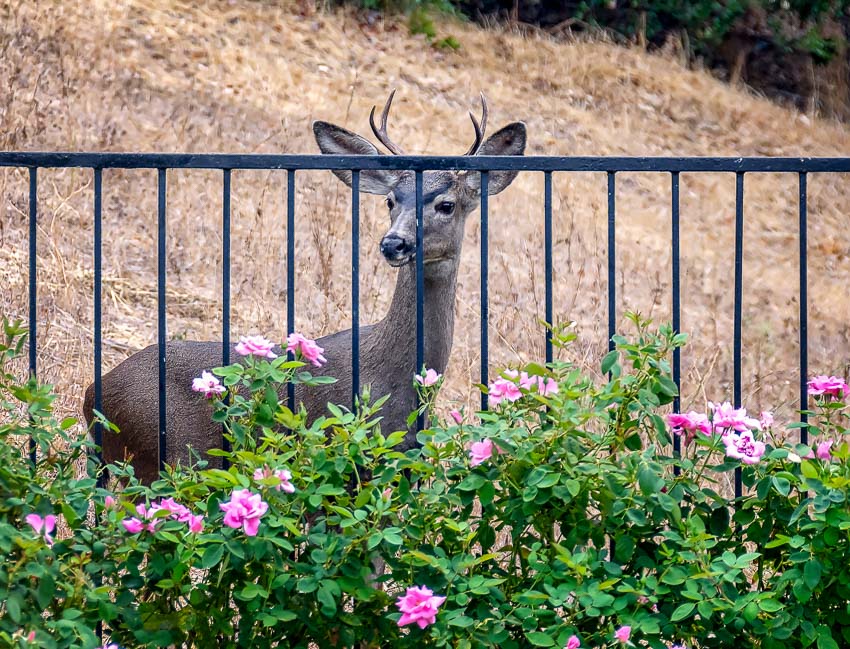Gardening in an area with a large deer population can be an exercise in futility. Most yard enthusiasts have tried numerous tactics for keeping deer out of their flowers and vegetables. Discover everything you need to know about deer behavior and how to get rid of deer with these effective methods.
Understanding Deer Behavior and Attraction
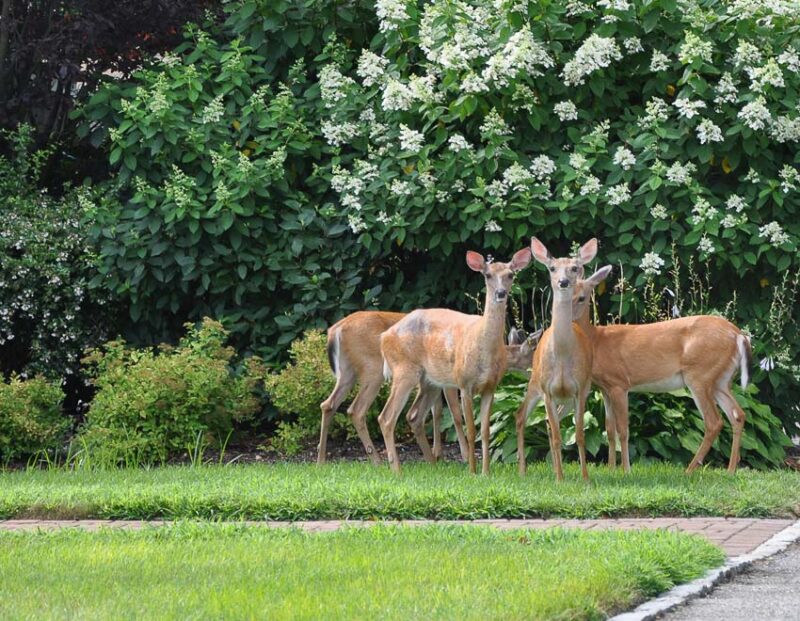
Keeping deer out of your yard and garden is easier when you have a basic understanding of their behavior. Learn more about what attracts deer to your property, their habits, and the factors influencing their behavior.
What Attracts Deer to Your Property?
Like all animals, deer need food, water, and shelter to survive. You can keep deer out of your yard by making it less enticing to them. Know what you shouldn’t have.
Food
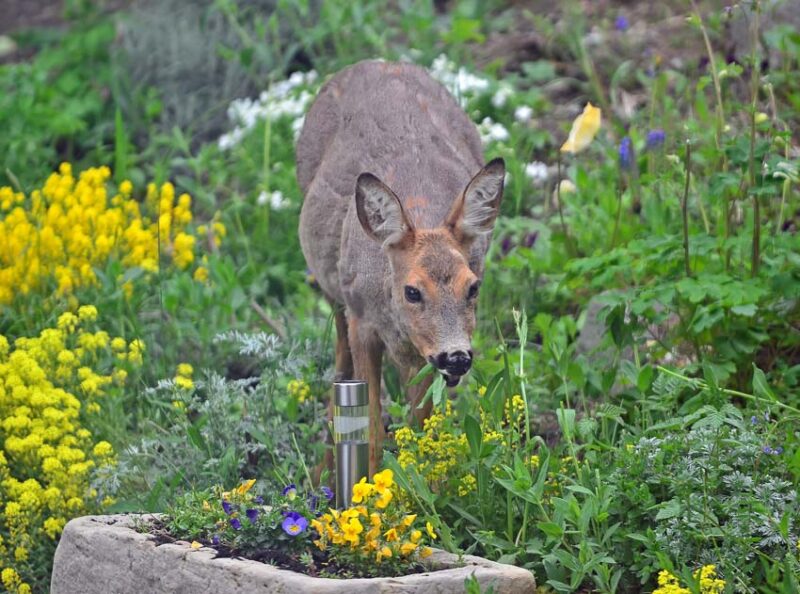
Deer graze on shrubs, trees, and grass, and they are particularly fond of high-protein crops like alfalfa, nuts, soybeans, and corn. Many prized flowers and vegetables growing in your yard and garden are also attractive to deer.
Water
If you have a pond or a pool in your yard, you’re more likely to have deer. While deer mainly move around to find food, they will travel up to 3 miles in search of water.
Shelter
Obviously, deer don’t need a roof over their heads like people do, but animals that have natural predators need cover for protection. Your neighborhood could provide the perfect cover for deer if there are a lot of trees and bushy areas.
Identifying the Habits of Deer
Knowledge of deer habits is helpful when you’re trying to keep them out of your yard. Deer are most active during the night and early morning, and they often use the same routes to travel through your yard and neighborhood.
Whitetails will often bed down in the same area for months before finding a new location.
Factors that Influence Deer Behavior
The three primary reasons for deer to move are food, breeding, and cover. Weather can also influence deer movement. Indeed, hunters utilize factors like precipitation, cold fronts, and barometric pressure to determine the movement of their prey.
Deer will also leave an area during hunting season or if they sense a predator.
The Pros and Cons of Having Deer in Your Yard
There are good reasons to keep deer out of your yard. They cause significant crop damage and can easily destroy a garden or flower bed in one night. Whitetail deer carry more ticks than any other animal, and they can carry other diseases in their fecal matter.
Perhaps most notably, they’re vectors for Lyme Disease.
Having deer in your yard isn’t all bad, though. Many people enjoy the beautiful sight of deer in their yards. In fact, they include various trees, shrubs, and plants in their landscaping that deer find appealing so they can watch them.
Effective Ways to Get Rid of Deer
Physical barriers are the most effective method for keeping deer out of the yard. Planting deer-resistant plants and using scare tactics and repellents are other strategies people use to get rid of deer. Most people combine at least two of these methods for the most successful approach.
Physical Barriers and Fencing
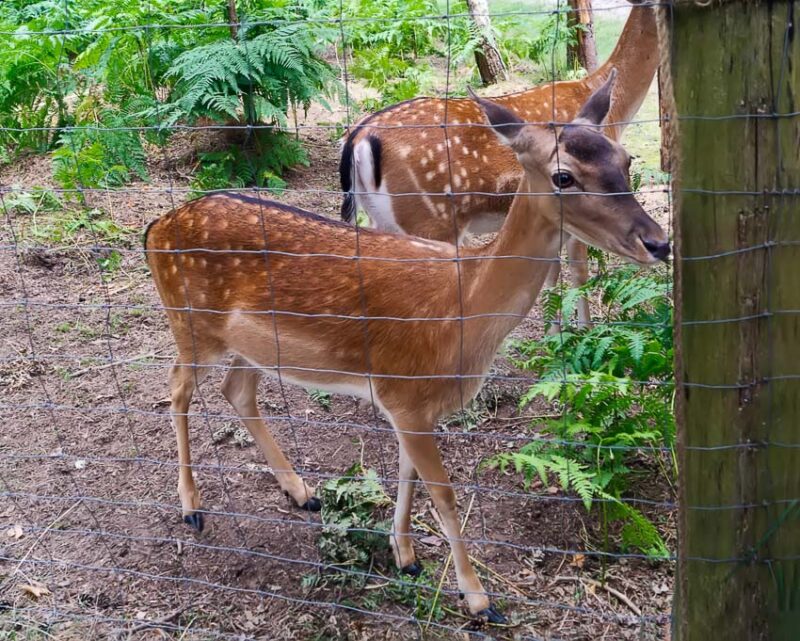
In areas where deer are rampant, you’ll need some type of fence to grow a garden. Fortunately, there are many different types of fences that will help you get rid of deer, including the following:
- Metal wire fencing is easy to install and durable, but it costs more than other options.
- Plastic mesh fencing is more affordable than wire mesh, but deer can break through it if they’re hungry enough.
- Double fences are a fence inside a fence. Sometimes the outside fence is electric.
- Vertical electric fencing is several strands of wire, including one or two electric ones.
Wireless fencing is another type of “fencing” that shocks deer and trains them to stay out of the yard. It’s also called a peanut butter fence because you lure them in using an attractant. When they touch their noses to an electric wire or post, it shocks them.
Fences can be expensive and take time to install. Another way to use physical barriers, if fencing a large area is not an option for you, is to make smaller cages and fence off individual plants or trees to keep deer from eating them.
Get Rid of Deer with Plants and Landscaping
Hundreds of plants are resistant to deer, so while you might not have some of your favorites, you can still choose from many types of plants that keep deer away from your yard. Strong-smelling herbs are especially deer-proof, and many of them bloom abundantly.
Here are a few of the most deer-proof plants:
- Iris
- Lamb’s ear
- Daffodil
- Purple coneflower
- Columbine
- Russian sage
- Snapdragon
- Bee balm
Sometimes deer have to try new plants to see if they like them, so don’t be surprised if they take a few bites.
Scare Tactics and Noise Deterrents
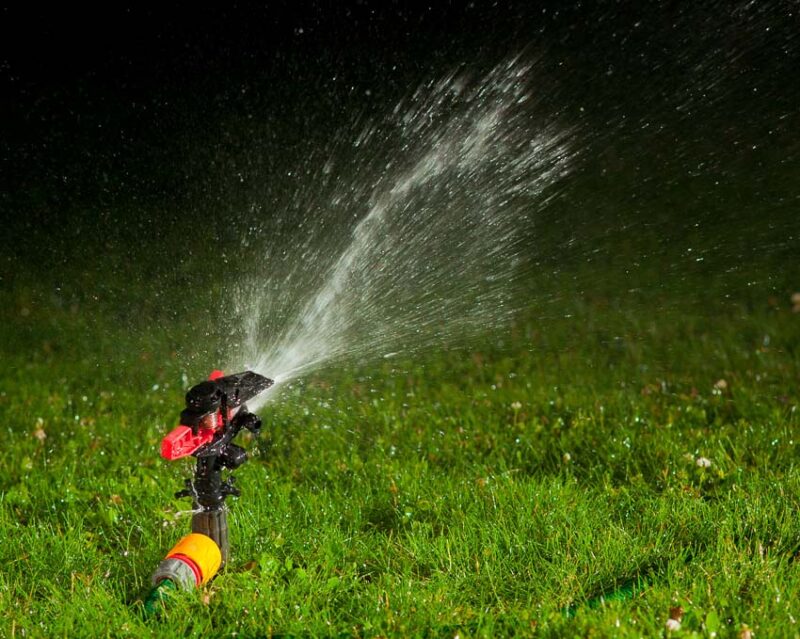
Devices that frighten deer work best when you deploy them at the first sign of a problem. Deer are creatures of habit, and if they have been living on your property for a while, it’s going to be tough to get them out of your yard.
Here are a few common types of scare tactics that help keep deer away:
- Gas exploders that produce loud banging noises
- Whistles
- Ultrasonic devices
- Flashing lights
- Radios
- Bells
- Alarms
- Wind chimes
- Predator decoys, including dogs and coyotes
Motion-activated sprinklers are one of the best scare tactics to get rid of deer, however, as with any deterrent, deer can get used to them over time. Motion-activated sprinklers are also useful for keeping other pests away, like stray dogs, feral cats, and raccoons.
Repellents and Odor-Based Solutions
There are a couple of approaches to odor-based deer repellents. Some repellents scare deer away with the scent of a predator, and others ward deer off using a scent that deer find unappealing.
Predator urine will help to get rid of deer. They are available in liquid and granule form for easy application, but they must be reapplied about once a week to remain effective. Use them in conjunction with deterrents like decoys and try multiple types of predator urine, including wolf, bobcat, mountain lion, and coyote, for optimum efficacy.
You can make homemade deer repellent and spray it on your plants so they find them unappealing. Use a mixture of cayenne pepper sauce, garlic powder, dish soap, and water, and apply it with a 1-gallon pump sprayer. Reapplication after rainfall is necessary, and you should keep it fresh by reapplying at least every two weeks.
Types of Deer Found in North America
A century ago, hunters and farmers almost completely wiped them out, but restoration efforts and stricter hunting regulations helped them to recover. Today, you’ll find deer in every state in the United States, but depending on where you live, you’ll be keeping different species out of your yard.
The whitetail deer and the mule deer are the only two species of deer native to North America. Technically speaking, black-tailed deer and Sitka deer are subspecies of mule deer.
White-tailed Deer
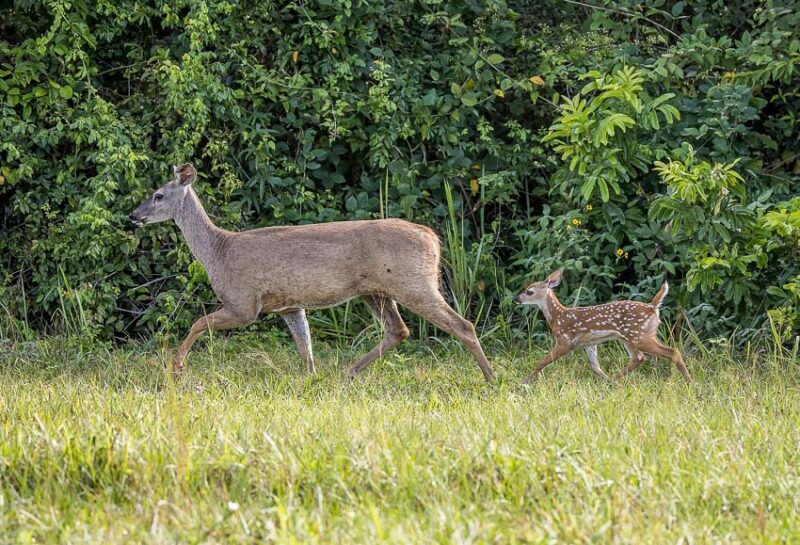
Whitetail deer are the most common species in the United States, with an estimated 30 million individuals. You’ll find them in every state except Alaska and Hawaii. And while some people claim to have seen whitetails in Alaska, wildlife experts have not substantiated those sightings.
The easiest way to identify whitetail deer is by their white tails that are raised as “flags” when they are alarmed. Whitetails are slender, with a reddish brown coat in the summer that turns to a dull gray-brown in the winter.
The antlers on males start growing in the spring. By the time the breeding season (or rutting season) comes around from August to February, they have a large set of antlers to attract mates and fight off other males.
Mule Deer
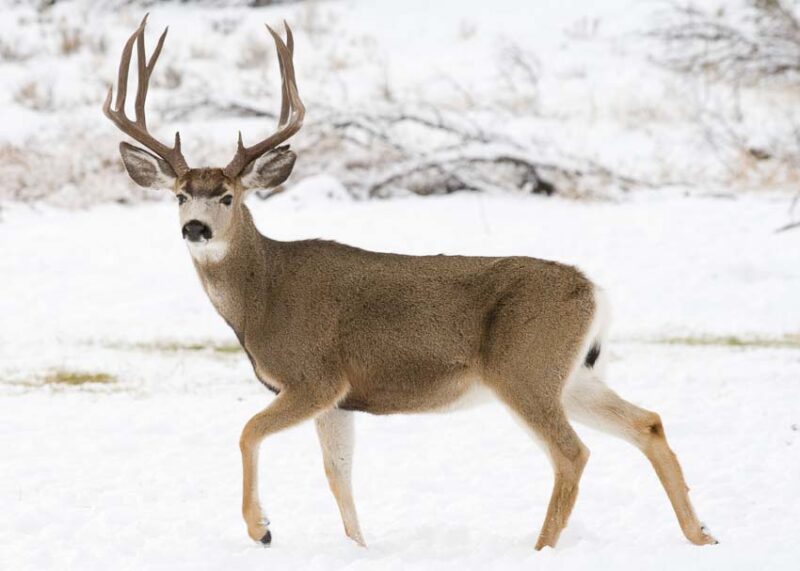
This species of deer is distinctive for its large ears, which resemble a mule’s ears. An estimated 4 million mule deer, including blacktail species, inhabit the United States.
The range of mule deer is smaller than whitetail deer, and they are primarily located in the Rocky Mountains and the Great Plains west of the Missouri River. They are well-adapted to brushy hillsides and arid environments.
One of the most noticeable differences between mule deer and whitetail deer is how they run to escape predators. Whitetail deer sprint and take long bounds, while mule deer use a jumping or hopping gait, where all four of their feet touch the ground at the same time.
Black-tailed Deer
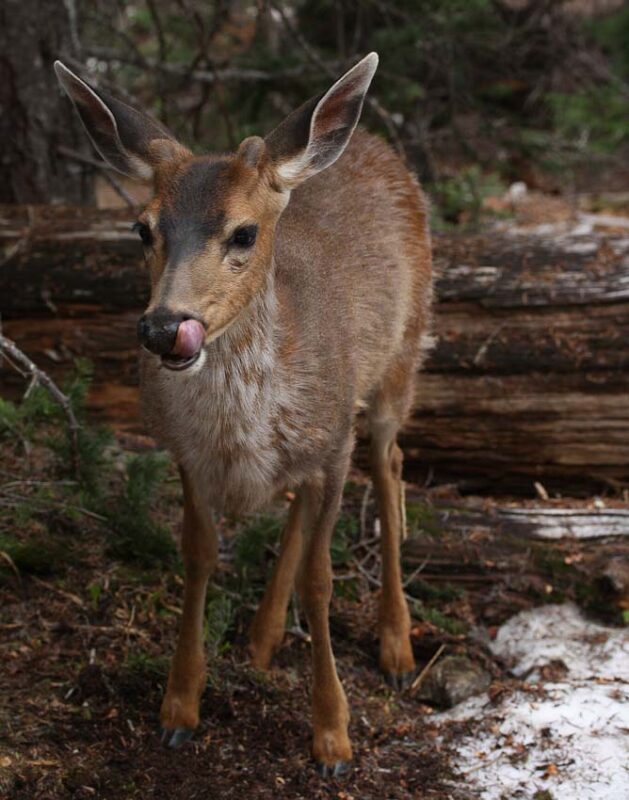
Blacktail deer (aka Columbia blacktail deer) form a smaller subspecies of mule deer and are native to the Pacific Coastal areas of California, Oregon, Washington, Canada, and Alaska. They closely resemble whitetail deer, but they are smaller. You can further differentiate them by their tails, as their names suggest.
Sitka Deer
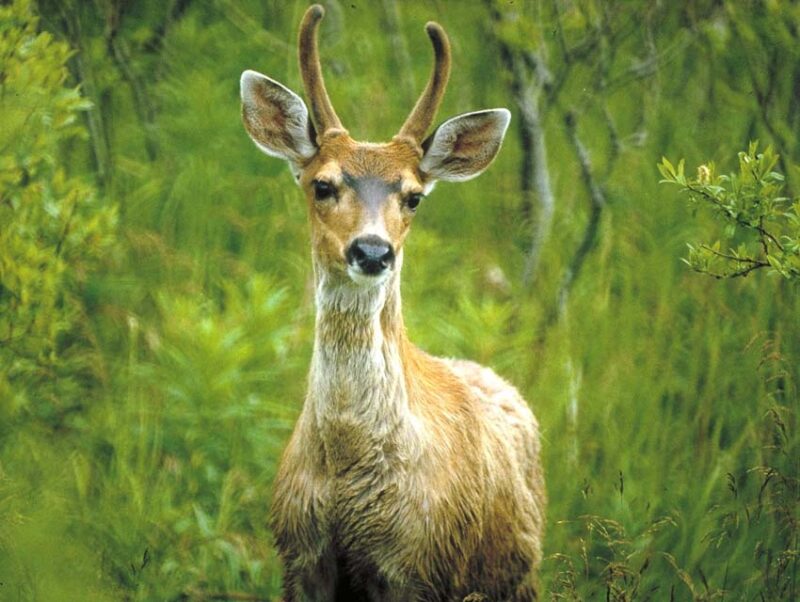
The best-known subspecies of blacktail deer is the Sitka deer, which is native to Southeast Alaska and the northern coastal regions of British Columbia. The territories of black-tailed deer and Sitka deer overlap, but there is little record of them interbreeding.
This species of deer is the smallest deer native to North America.
Non-native Deer in the US
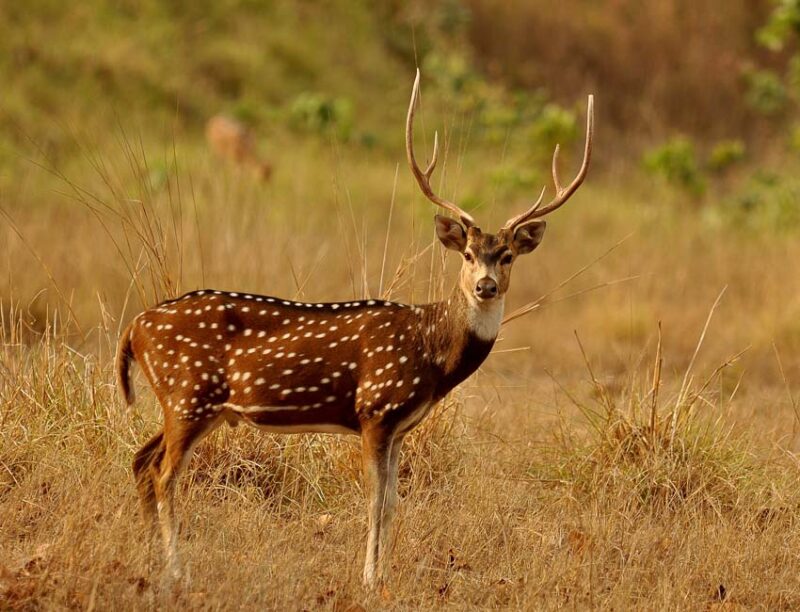
Several non-native deer species live in the United States, and while their populations are much smaller, they can still contribute to crop damage. The axis deer is a species that lives in Hawaii after eight of them were gifted to King Kamehameha in 1867. There are now over 60,000 on Maui.
Many of the non-native deer in the US live in Texas, but several species live all over the country. Axis deer, sika deer, fallow deer, and sambar deer have all come from other continents and have naturalized in parts of the US.
How to Keep Deer Out of the Yard FAQs
How much damage can deer cause to my garden?
Deer like to eat all of the plants that grow in a vegetable garden, and left unchecked, will completely destroy a garden. In areas where deer are a problem, growing a garden isn’t successful without some kind of fence. Deer can also destroy lawns by overgrazing and creating bare spots.
What are some natural repellents to get rid of deer?
One of the best natural deer repellents is cayenne pepper, but most deer will avoid many types of herbs, including lavender, basil, rosemary, oregano, and thyme. Onions, garlic, and chives will also keep them out of your yard.
Do motion-activated sprinklers keep deer out of your yard?
As long as you install them properly, motion-activated sprinklers will deter deer. They also deter other nuisance animals in your yards, including dogs, cats, and raccoons.
Are there any plants that deer won’t eat?
There are many plants that deer won’t eat, and some people enjoy a garden full of deer-resistant plants. Irises, daffodils, foxgloves, and poppies are some of the flowers that deer will avoid. Shrubs like juniper, cotoneaster, and spirea are deer-resistant, and even if they get nibbled on, it doesn’t destroy them.
Is it legal to hunt or trap deer to control their population?
Deer are a protected species, and the United States Department of Fish and Wildlife manages the population of deer by setting harvest dates to control the population. In some cases, deer are trapped in places like city parks and relocated, but it’s illegal for individuals to trap deer.
Successfully Deterring Deer from Your Property
When it comes to keeping deer out of your yard, you can choose from several effective methods. But it also helps to understand and identify the habits of the deer in your neighborhood. Fences are the most effective strategy for keeping deer out of a garden, but they aren’t always an option.
Controlling deer damage to crops, yards, and gardens is a complex problem; learning how to live with them is a fact of life for many homeowners. Overall, deer are a big nuisance for farmers, gardeners, and yard enthusiasts. Still, they are a valuable wildlife resource, which is why they are a protected species.
If you’ve had deer in your yard, there’s a good chance you’ve got ticks there, too. Thankfully, OPE has the 411 on effective tick treatments for yards!

